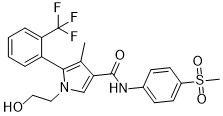| Reference | 1:Xenobiotica. 2016 Dec 12:1-14. doi: 10.1080/00498254.2016.1263766. [Epub ahead of print] Pharmacokinetics, distribution, and disposition of esaxerenone, a novel, highly potent and selective non-steroidal mineralocorticoid receptor antagonist, in rats and monkeys.Yamada M,Takei M,Suzuki E,Takakusa H,Kotsuma M,Washio T,Murayama N,Inoue SI,Izumi T, PMID: 27866463 DOI: 10.1080/00498254.2016.1263766 </br><span>Abstract:</span> 1. Esaxerenone (CS-3150) is a novel non-steroidal mineralocorticoid receptor antagonist. The pharmacokinetics, tissue distribution, excretion, and metabolism of esaxerenone were evaluated in rats and monkeys. 2. Following intravenous dosing of esaxerenone at 0.1-3 mg/kg, the total body clearance and the volume of distribution were 3.53-6.69 mL/min/kg and 1.47-2.49 L/kg, respectively, in rats, and 2.79-3.69 mL/min/kg and 1.34-1.54 L/kg, respectively, in monkeys. The absolute oral bioavailability was 61.0-127% in rats and 63.7-73.8% in monkeys. 3. After oral administration of [14C]esaxerenone, the radioactivity was distributed widely to tissues, with the exception of a low distribution to the central nervous system. Both in rats and in monkeys, following oral administration of [14C]esaxerenone the main excretion route of the radioactivity was feces. 4. Five initial metabolic pathways in rats and monkeys were proposed to be N-dealkylation, carboxylation, hydroxymethylation, O-glucuronidation, and O-sulfation. The oxidized metabolism was predominant in rats, while both oxidation and glucuronidation were predominant in monkeys.
|

